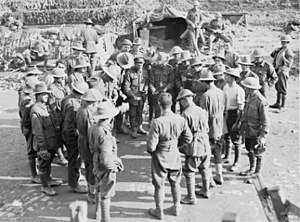Two-up

Two-up or Swy (after the German word " two ") is a from Australia originating gambling . It is probably the only casino game in which coins are tossed - unless it is played with dice (see below).
Two-up originated during the Australian gold rush in the 1850s. During the First World War it was particularly popular among the members of the Australian and New Zealand Army Corps , so it is played every year on ANZAC Day , the day commemorating the landing on Gallipoli on April 25, 1915.
The rules
General
Two-up is played in a circular arena ( pit or ring ) about six meters in diameter, on the outer edge of which the bets are placed. The croupier ( boxer ) selects a player and asks him to step into the ring through a recess , shouting " Come in, crazy! "
After the spinner , i.e. H. the player in the arena and the spectators have placed their bets, it says " No more bets, please! "; and two coins, authentic old pre-decimal Australian pennies , are placed in two small hollows provided on an approx. 20 cm long board ( kip ) so that the head of one coin and the number of the other are visible. The spinner now hurls the two coins up; these must be thrown at least one meter high and should also spin (English to spin , hence also spinner ) - otherwise the throw is invalid ( barred ).
Throws
If both coins show the same side, the result is called heads or tails, depending on the case ; If one coin shows heads , the other tails , the result is called odds (a draw).
Spinner bet
Sets the spinners on Heads , he wins in the ratio 7.5 to 1 when three Heads throws before the first time Tails or a sequence of five odds appear. The procedure is very similar if the spinner relies on tails .
The probability of winning with the bet of the spinner is 11.364%, the bank advantage is 3.403%.
If the spinner wins , he can continue playing; if he loses, he has to leave the arena and the boxer asks a new player into the ring.
Non-spinner bets
Spectators can also bet on heads or tails ; The procedure for betting the spectators is as follows:
If a viewer z. B. on heads , he wins a ratio of 1: 1 if heads are thrown and loses if tails are thrown . In the event of a throw of odds , no decision is made for the time being, the bets are frozen until heads or tails appear.
But if the spinner throws odds five times in a row , all bets are lost - in this way the probability of winning is only 48.4375%, and the casino thus secures an advantage of 3.125%.
Every time the spectators' bets are decided, a new round of non-spinner bets begins .
odds
If a player wants to bet that the spinner will throw odds on the next five throws , he makes a bet on odds and, in the lucky case, wins at a ratio of 30 to 1.
The probability of winning this bet is 1/32 = 3.125%; the bank advantage is also 3.125% and is therefore the same as with the non-spinner bets on heads or tails .
Two-up dice
Two-up is also played as a two-up dice ; Instead of coins, special dice are used which are marked on three sides with the letter H for heads and on the remaining three sides with a T for tails . The H s and T s are arranged in such a way that - just like with a coin - each H is opposite a T and vice versa.
Furthermore, exactly the same rules apply to the dice game Two-up dice as to Two-up , the game with coins.
literature
- Ralph Tegtmeier : Casino. Die Welt der Spielbanken - Spielbanken der Welt , DuMont, Cologne 1989, p. 245
Web links
- Rules of Casino Skycity Darwin, Australia ( Memento from March 20, 2012 in the Internet Archive )
- Casino Gaming Rules of Queensland, Australia (PDF; 2.2 MB)
